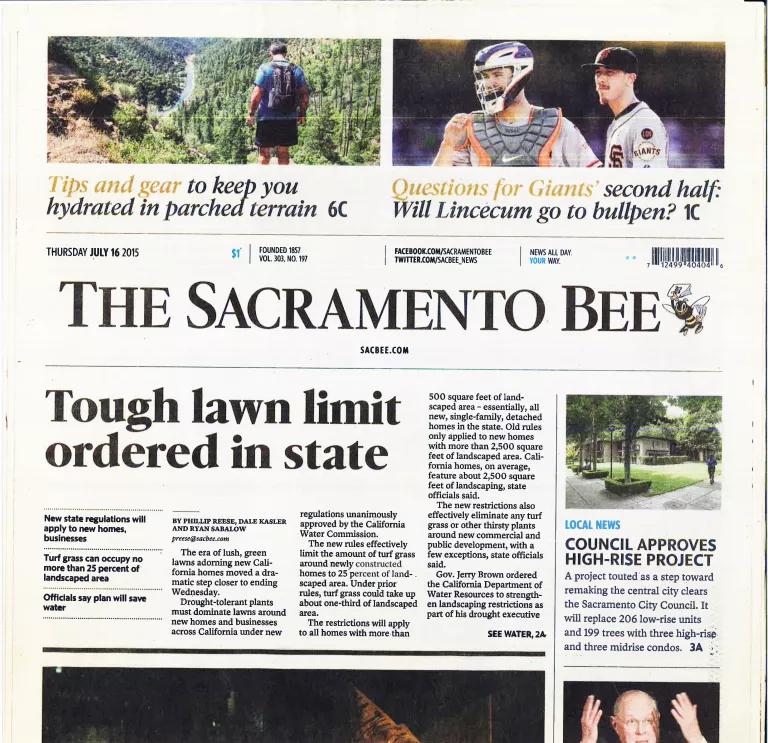1,100 Reports Missing: NRDC Files Suit on Water-Saving Rules

Did the dog eat their homework? We haven’t found a better excuse from the estimated 340 California cities and counties that have failed to file annual reports on landscape water use with the state’s Department of Water Resources. So this week, the Natural Resources Defense Council (NRDC) took the unprecedented step of filing a lawsuit against a proposed class of more than half of all cities and counties in California over their failure to report on their local permit programs for new irrigated landscapes, as required by state regulations.
NRDC found that one of California’s most venerable water conservation laws, the Water Conservation in Landscaping Act of 1990, is also one of its most widely disregarded. Under the law, all cities and counties are to review new irrigated landscapes when issuing building permits. Under regulations adopted in 2015, cities and counties are to report to the state each year on their landscape permitting activities. These reports include much vital information for evaluating the success of local permit programs, including the number of permits issued, the efficiency requirements that apply, the square footage of new irrigated landscapes, and local procedures for inspection and enforcement. Data is submitted on a simple report form provided by the Department of Water Resources (DWR).
However, for each of the years 2015, 2016, and 2017, only about 30% of cities and counties filed the required reports with the state. And even after DWR sent reminder letters last May to jurisdictions that had missed the January 2019 deadline for their 2018 reports, the needle barely moved. 50% of cities and counties still did not file their report for 2018. On November 15, NRDC sent letters to more than 400 local jurisdictions that – according to DWR’s website – still had one or more missing reports, urging them to file promptly. Although more than 100 local governments heeded NRDC’s request, over 300 have failed to meet their responsibility to file. In the face of such widespread non-compliance, NRDC brought this class action case.
NRDC’s New Filing
NRDC has filed a petition for a Writ of Mandate in Superior Court in San Bernardino County seeking compliance with state regulations, naming as respondents the County of San Bernardino and the Cities of Chino Hills, Rancho Cucamonga, and Redlands – on behalf of themselves and also on behalf of a proposed respondent class of California cities and counties that have failed to file one or more of the reports required for the years 2015, 2016, 2017, and 2018. Based on information available to NRDC, these four named jurisdictions have together failed to submit 12 annual reports. Altogether, NRDC estimates that there are 338 cities and counties that make up this proposed class, with some 1,094 annual reports still unfiled. In coming weeks, NRDC will seek judicial approval of a class of jurisdictions that have not complied with their duties to submit annual reports.
In its petition, NRDC seeks relief through an order from the court requiring local jurisdictions to
- Submit complete and accurate reports for the years 2015 through 2018 that have not already been submitted as of today’s date; and
- Submit complete, accurate, and timely reports for 2019, which are due by January 31, 2020, and each year thereafter.
No fines or penalties are provided for in the statute, and none are being sought in NRDC’s lawsuit. If successful, NRDC will seek recovery of reasonable attorneys’ fees and costs.
The jurisdictions named in the petition each have experienced robust new development since 2015, and taken together have issued building permits for thousands of dwelling units and accompanying landscapes. For example, San Bernardino County, which has permitting authority in unincorporated areas, has issued permits for over 2,200 dwelling units from December 2015 through 2018 without reporting to the state the amount of irrigated area and the water-conserving standards that were applied, as required by state regulations. Chino Hills has yet to report on its permitting programs for 2015, 2016, and 2017, during which time permits for over 1,500 dwelling units were issued by the city.
A list available here reflects information NRDC has gathered regarding the reporting status of all local governments in California.
The Importance of Landscape Regulations
Across California, the amount of drinking water used for landscape irrigation is enormous. In a normal year without drought restrictions, half of all water in urban areas is used outdoors. An estimated 2 million acres of turf grass surround homes and businesses in the state, nearly all of it requiring irrigation. For the state to support a growing economy with reliable supplies of drinking water, it is critical that all new urban landscapes be designed and installed to be water-efficient, as well as attractive.
The landscape reports themselves, if complete and accurate, will provide a rich body of data that can illuminate the effects of current policies and chart trends in new development and water use. Local residents, water districts, state agencies, and university researchers all stand to benefit from a comprehensive database of landscape installation across all of California – if, and only if, local governments comply with the state’s annual reporting requirement.
25 Years of State Policy

In 1992, the Department of Water Resources (DWR) first published a model ordinance to guide cities and counties in their efforts to help improve the water efficiency of new landscapes. Known as the Model Water Efficient Landscape Ordinance (MWELO), the ordinance was flexible to allow for creative and attractive designs for new landscapes, but local adoption and enforcement was uneven. At the direction of the Legislature, MWELO was strengthened and made mandatory in 2009. Communities were given the choice to adopt MWELO or to adopt a locally-written ordinance that would be at least as effective in conserving water. In 2015, at the height of the drought emergency, the regulations were strengthened again, and a reporting requirement was added to compile information on local landscape permit activities. The failure of so many jurisdictions to file these reports led to NRDC’s decision to file this case.
How California’s Landscape Regulations Save Water
Although people manage landscapes differently over time, MWELO applies to the design and installation of new and renovated landscapes so that efficient water use is possible and practical for that location, and new landscapes are less likely to waste water
The water savings achieved by MWELO are largely attributable to a “water budget” that is calculated on a worksheet submitted by the applicant for each landscape. The water budget concept allows for flexibility in the selection of plant material and irrigation equipment, provided that the combination of these elements complies with the water budget calculated for the site. The worksheet generates a maximum water allowance that the landscape must be designed to achieve. MWELO also takes into account the differences in climate across California through the use of location-specific adjustments to plant water use calculations. This allows MWELO to be adopted and applied by local jurisdictions throughout the state, even those with very different climates.
And like other water efficiency measures, water-efficient designs for new landscapes are far less expensive than traditional approaches to providing drinking water with new dams, canals, and treatment projects. Efficient irrigation equipment is widely available, as are a great variety of attractive landscape plants that require little to no irrigation.
Look for Updates Ahead
This week marks the first step toward more comprehensive reporting of landscape installation and irrigation water use throughout California. While it is too early to predict the outcome of the case, the public discussion it will prompt is only just beginning. Look for updates over the weeks and months ahead as we work to get more information into the public domain and to daylight the steps needed to protect and sustain California’s public water supplies.